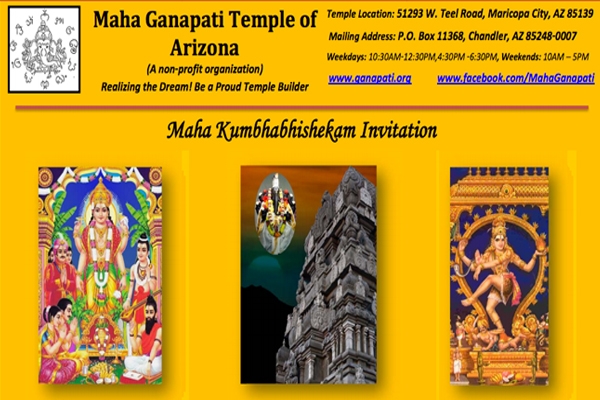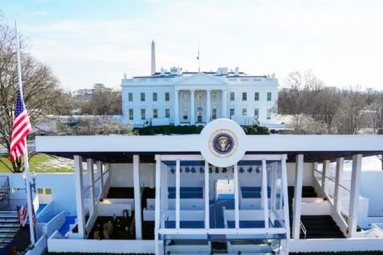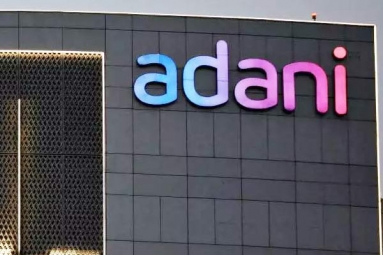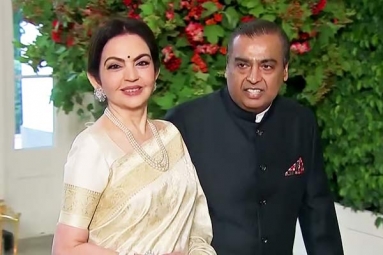
(Image source from: Maha Ganapati Temple of Arizona hosts Prathama Maha Kumbabhishekam})
"Sarvaroga Nivrityartham, Sarva Yaga Phalapradham Sarva Sampathkaramnreenam putrapoutrabhi vardhanam"
The Maha Ganapati Temple of Arizonahosted the first consecration ceremony of the temple — the “Maha Kumbabhishekam”, a 3-day ceremony that was solemnized between May 9th, 2014-11th May 2014 at the temple premises in Maricopa City.
Devotees thronged the temple during the three days of spiritual occasion and took part in this once-in-a-lifetime event to seek the blessings of Lord Ganesha, Lord Balaji and Lord Shiva as their shrines got sanctified. The main events of the ceremony included Moola Aalaya Vimaana (Gopuram) for Sri Maha Ganapati, Sri Viswanatha (lord Siva), Sri Venkateswara (lord Balaji) & Murthi-Prana-Prathishtapana of Lord Sathyanarayana & Sivgagama Sundari Sametha Nataraja.
Significance of Maha Kumbhabishekam
The ceremonies of Kumbahbhiskekam of a temple are doused in tradition, dating back to the Agama Shastras. The scriptures detail the extensive process of building and maintaining a temple along the religious lines. Kumbhabhishekam (Kumbha-Shikhara or crown of the temple, Abhishekam-sanctification with spiritually charged water) is executed to sanctify newly erected shrines, re-consecrate old shrines post-renovation or every twelve years. Trained priests, well-versed with the shastras, perform a wad of sacred ceremonies over three days of Kumbhabhishekam.
The significance of some of the ceremonies are explained below:
Sri Maha Ganapati Puja & Sri Viswakshena Puja and Swasti Punyaha Vachanam: Lord Ganesha as Maha Ganapati and Viswakshena are placated to eradicate all obstacles for the ceremonies. This is followed by Punyaha Vachanam to purify the temple and the Yaga Shala.
Homam/Havan/Yajna: Priests performs homams by offering ghee, grains and spices to the fire. Mantras are chanted to invoke the holy spirit. Ganapati Homam (to remove all obstacles), Sudarsana Homam (for peace and victory over negative energies), Navagraha Homam (to alleviate malefic effect of Navagrahas and to appease the Navagrahas), Vaastu Shanti Homam (for the worship of the elements of nature and balance the forces that control the flow of energies), Moola Mantra Homam (oblations to the deities residing in the temple by chanting the Moola Mantra of each deity). In addition, Adi Vaasa Homam, Nyaasa Homam, Panch Sooktha Homam, Durga Trisathi Homam and Kalaan Yasa Homams are all performed during the Yajna.
Adhivasam: This marks as the immersion ceremony done to wash away the vigrahas. It is said that when the the sculptors sculpt the vigrahas, a great deal of agony is inflicted on the granite every time the chisel hits the stone. By soaking the vigraha in water, milk, flowers and paddy, it is cleansed and cooled of all negative energies. Dhanyaadhivasam: immersion of deities in paddy. Jalaadhivasam: immersion in water. Pushpaadhivasam: immersion in flowers.

Netronmeelanam: The ceremony where the sculptor opens the eye of the vigraha using a silver awl.
Go (cow) Puja: According to the scriptures, all the 330 million Hindu devas, including Maha Lakshmi reside within the cow. The cow, after the puja is led into the temple in a ceremonial procession.
Yantra and Navaratna Sthapana: Yantras are geometric representations of the power of the deity etched on gold, silver or copper plates. These along with the navaratnas (9 gems) are offered where the deities will be placed. These elements are said to glow in the inner worlds and are prominently visible to the Gods and Devas.
Ashtabandhana: A special mix of eight special ingredients are made to affix the vigraha to the peetam (pedestal). This paste is usually made by the shilpis or the sculptors during a special occasion. This paste creates a watertight seal between the vigraha and the peetam.
Jeeva Kala Avahana: This rituals involves the passing of energy into the vigraha through chanting spiritually charged mantras. That way, the vigraha gets all attributes of a deity.
The organizers of this non-profit organization opened their gates to devotees to participate in the spiritual fest and obtain some of the divine energies that permeated the temple during this time. Not just that, the devotees also got a chance to touch the vigrahas and perform pujas during the events.

Venue: Maha Ganapati Temple of Arizona
51293 W.Teel Road, Maricopa City, AZ 85239
About the Mahaganapati Temple of Arizona:
The Mahaganapati Temple of Arizona serves the spiritual needs of devotees in the Greater Phoenix metro, Tucson and Southwestern United States. The temple is located in serene surroundings with the open desert on one side and mountains on the other. Built in true Agamic traditions, Maha Ganapati Temple houses the shrines of Lord Maha Ganapati, Lord Viswanatha and Goddess Visalakshi, Lord Venkateswara and Goddess Padmavati, Valli Devasena Sametha Sri Subramanya, Lord Ayyappa, Navagrahas and the Murti of Pancha Mukha Anjaneya.
Watch the video of the event here:























